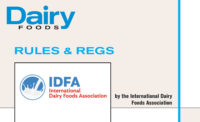Ever since Louis Pasteur first discovered that heating milk could kill contaminating microorganisms and thus improve its safety and quality, the food supply has improved by leaps and bounds.
Today, consumers in the United States can experience a huge variety of affordable, fresh and innovative dairy foods, not only from across the country, but also from around the globe, just by visiting the local grocery store — an experience that was considered impossible only a few decades ago. Advances in food science, processing, packaging and a tremendous expansion of the cold chain distribution system are a few of the ways by which this progress has been achieved.
A process of continuous improvement
Despite these many advances, however, ensuring the absolute safety of the food supply is a goal we have not yet been able to completely reach. The fact is, potentially harmful microorganisms are part of the natural eco-system. Thus, they can be associated with many of the raw materials we use in food production, including animals, fruits, vegetables and grains. Like in so many other areas of quality control, food safety today is a process of continuous improvement, requiring us to consistently seek to find and correct problems and work toward lowering the risk that these organisms find their way into finished product.
This is particularly important for ready-to-eat (RTE) foods where there isn’t a final heat step applied to the finished product prior to consumption, which would be lethal to any pathogens that might be present. And one of the usual suspects for bacterial pathogens that much of the RTE food industry is focused on is Listeria monocytogenes (“Lm”). This organism can affect a wide variety of foods — from dairy to fresh produce to seafood — because of its ability to thrive in a variety of environments, especially the cold, damp environments typically found in RTE dairy food plants.
In an effort to enhance the industry’s ability to deal with this pathogen, the International Dairy Foods Association (IDFA) remains very active in a variety of important industry initiatives to ensure the safety of dairy foods and beverages. The International Ice Cream Association (IICA), for example, which is under the IDFA umbrella, has worked over the past year to provide valuable resources and share knowledge and insights with and among members of the ice cream industry to help maintain the overall positive food safety track record ice cream products have enjoyed.
A Listeria-control document
A team of dairy industry food safety experts has also just finalized an in-depth, yet practical Listeriacontrol guidance document for RTE dairy products. The guidance is essentially a written version of the Dairy Plant Food Safety Workshops that IDFA and the Innovation Center for U.S. Dairy offer throughout the year. These workshops provide invaluable, expert instruction on controlling Lmand other pathogens, such as Salmonella, in a variety of dairy food and beverage production environments.
Furthermore, working with the Alliance for Listeriosis Prevention, which consists of various food industry trade associations and individual companies, IDFA is encouraging the FDA to harmonize its Listeriaregulatory policy with that of the U.S. Department of Agriculture’s Food Safety and Inspection Service. Such alignment would encourage manufacturers of ready-to-eat products to aggressively test for Listeriaand address potential concerns quickly before a bigger problem arises, which results in illness and product recalls. Having such policy alignment between the two agencies will significantly help the food industry, both domestic and foreign, better comply with food safety regulations and, for dual-jurisdiction facilities (those producing both FDA- and USDA-inspected food), avoid operating under differing enforcement policies.
Although our industry has been doubling down in recent years to seek out and destroy Listeriawhenever and wherever they find it, as the Food Safety Modernization Act begins to be enforced in late 2016, giving U.S. Food and Drug Administration inspectors the ability to scrutinize facilities’ internal testing records, it will be evermore vital that the dairy foods industry has tight control over these bacteria and maintains thorough documentation that will meet FDA’s expectations.
For more information and resources about how to tackle Listeria and other hazards that might impact your products or for guidance on how to prepare for the new brand of FDA inspections coming soon, contact us at 202-737-4332.


